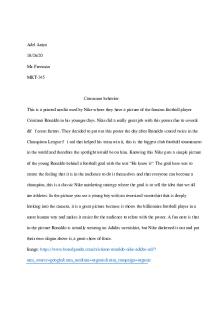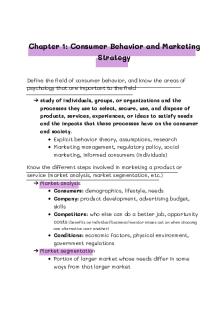Behavior Mod-Study Guide Reinforcers PDF

| Title | Behavior Mod-Study Guide Reinforcers |
|---|---|
| Course | Applied Behavior Analysis I |
| Institution | Valdosta State University |
| Pages | 4 |
| File Size | 89.3 KB |
| File Type | |
| Total Downloads | 11 |
| Total Views | 149 |
Summary
Download Behavior Mod-Study Guide Reinforcers PDF
Description
Behavior Modification Reinforcers
Automatic conditioned reinforcer: A reinforcing effect produced by a response due to the resemblance of that response to a CR Backup reinforcers: A positive reinforcer that is presented in exchange for another stimulus, causing it to become a conditioned reinforcer
When a stimulus becomes a conditioned reinforcer through deliberate association with other reinforcers, the other reinforcers are called ___________ Example: dolphin trainer pairs sound from clicker with delivery of fish to dolphin. Fish = _________ and clicking sound becomes conditioned reinforcer
Can be conditioned or unconditioned
Conditioned punishment: A stimulus that is paired with punishment becomes punishing itself
Examples: "No!" and "Stop that!" because often followed by punishment for continuing the behavior; demerit system used in the military = punishment token system
Conditioned reinforcers (AKA secondary or learned reinforcers): Stimuli that were not originally reinforcing but have become reinforcers from being paired/associated with other reinforcers
Examples: praise, a pic of a loved one, books and TV shows we like, and clothes that make us look good. Also: stimuli that's been paired with addictive drugs (e.g., smell/taste of substances containing drug or sight of paraphernalia used to prepare/administer drug)
Factors influencing the effectiveness of conditioned reinforcement: 1) history of reinforcement/punishment - after training first behavior, easier to train subsequent behaviors
2) genetic predispositions (example: high vs low voice pitch) 1
Behavior Modification Reinforcers
3) strength of backup reinforcers - reinforcing power of CR depends in part on reinforcing power of backup reinforcer(s)
4) the variety of backup reinforcers - reinforcing power of CR depends in part on number of different backup reinforcers with which it's been paired (want to use generalized conditioned reinforcers because if many different backup reinforcers are available, at any given time at least one of them will probably be strong enough to maintain the conditioned reinforcer at a high reinforcing strength)
5) the number of pairings with a backup reinforcer - CR stronger if paired with backup reinforcer many times
6) schedule of pairing with backup reinforcer - more effective if it doesn't follow each occurrence (i.e., intermittent)
7) extinction/loss of value of a conditioned reinforcer - for CR to remain effective, must continue to be paired with backup reinforcer at least occasionally
Generalized conditioned reinforcer: A stimulus that is paired with more than one kind of backup reinforcer
Examples: money, praise, a gift certificate for food and beverages at a restaurant
Guidelines for effective use of conditioned reinforcement: 1) CR should be a stimulus that can be easily managed and administered in a variety of settings
2) use the same CRs that individual will encounter in their natural environment (ex: common praise words) 2
Behavior Modification Reinforcers
3) in early stages of establishing CR, present backup reinforcer ASAP after presentation of CR (delay can be increased gradually later. 4) use generalized conditioned reinforcers whenever possible (wider variety of backup reinforcers) 5) when program involves more than one individual, avoid destructive competition for conditioned and backup reinforcers (giving one person reinforcement to the detriment of another may cause aggressive behavior in second individual or cause their desirable behavior to extinguish) 6) apply same rules used for primary positive reinforcers Main advantage of using conditioned reinforcers: They can usually be delivered more immediately than the backup reinforcer can; help to bridge delays between behavior and more powerful reinforcers No problem with satiation (like with primary reinforcers) Pitfalls of conditioned reinforcement: 1) unaware-misapplication: unknown pairing of conditioned reinforcers with stimuli that are meant to be punishing. (Example: when an adult frequently reprimands a child for behaving inappropriately but (a) never provides any type of backup punisher, and (b) the reprimand is accompanied by other aspects of adult attention that have acquired conditioned reinforcing value. Therefore, reprimands might become CR which the child will behave inappropriately to attain.) 2) partial-knowledge-misapplication: ceasing to pair a conditioned reinforcer with a backup reinforcer, causing the CR to lose its value (become extinguished). (Example: teacher awards stamped happy faces for good behavior but fails to use effective backup reinforcers.) Praise as generalized conditioned reinforcer: A mother who expresses pleasure at her child's good behavior is disposed to smile at, hug, or play with the child. Established during childhood, but continues to be maintained as adults because when people praise us they're 3
Behavior Modification Reinforcers
more likely to favor us in various ways than when they don't praise us. So we are highly likely to engage in behaviors that are followed by praise, even when not deprived of any specific reinforcer. Simple conditioned reinforcer: A conditioned reinforcer that's paired with a single backup reinforcer Examples: sound of ice cream truck, air miles, a subway token, a coupon for a free hamburger, and being told in a restaurant "a waiter is coming to take your order" Token economy/ token system: A behavior modification program in which individuals can earn tokens for specific behaviors and can cash in their tokens for backup reinforcers Tokens: Conditioned reinforcers that can be accumulated and exchanged for backup reinforcers Unconditioned reinforcers (AKA primary or unlearned reinforcers): Stimuli that are reinforcing without prior learning or conditioning. Examples: food, water, sex, physical comfort, sleep, novelty Subjects
4...
Similar Free PDFs

Behavior contracts
- 3 Pages

Consumer behavior
- 5 Pages

Deviant Behavior
- 3 Pages

Organizational Behavior
- 39 Pages

Prioritizing Behavior
- 7 Pages

Defining Behavior
- 4 Pages

Consumer Behavior
- 33 Pages

Organizational Behavior
- 51 Pages
Popular Institutions
- Tinajero National High School - Annex
- Politeknik Caltex Riau
- Yokohama City University
- SGT University
- University of Al-Qadisiyah
- Divine Word College of Vigan
- Techniek College Rotterdam
- Universidade de Santiago
- Universiti Teknologi MARA Cawangan Johor Kampus Pasir Gudang
- Poltekkes Kemenkes Yogyakarta
- Baguio City National High School
- Colegio san marcos
- preparatoria uno
- Centro de Bachillerato Tecnológico Industrial y de Servicios No. 107
- Dalian Maritime University
- Quang Trung Secondary School
- Colegio Tecnológico en Informática
- Corporación Regional de Educación Superior
- Grupo CEDVA
- Dar Al Uloom University
- Centro de Estudios Preuniversitarios de la Universidad Nacional de Ingeniería
- 上智大学
- Aakash International School, Nuna Majara
- San Felipe Neri Catholic School
- Kang Chiao International School - New Taipei City
- Misamis Occidental National High School
- Institución Educativa Escuela Normal Juan Ladrilleros
- Kolehiyo ng Pantukan
- Batanes State College
- Instituto Continental
- Sekolah Menengah Kejuruan Kesehatan Kaltara (Tarakan)
- Colegio de La Inmaculada Concepcion - Cebu







